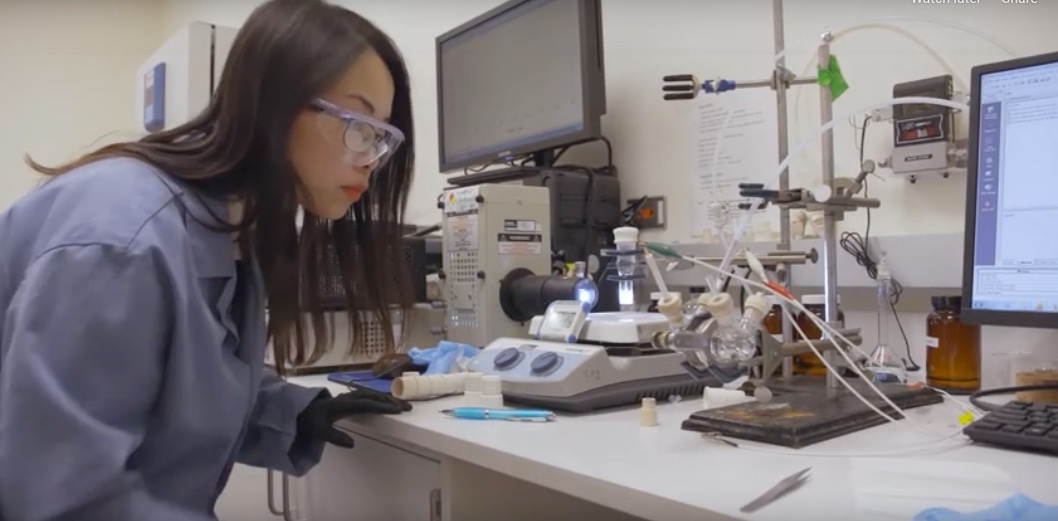Daily Business Report-Oct. 13, 2020
(Photo courtesy of U.S. Navy)
General Atomics’ aircraft launches
and landings reach big milestone
General Atomics Electromagnetic Systems (GA-EMS) announced that a milestone of 4,492 catapult launches and landing arrestments using the Electromagnetic Aircraft Launch System (EMALS) and Advanced Arresting Gear (AAG) system has been successfully and safely achieved aboard USS Gerald R. Ford.
“CVN 78 passed the half-way mark of its PDT&T, and we are well underway toward achieving the cats and traps milestones by the end of this rigorous testing phase,” said Scott Forney, president of GA-EMS. “In addition to the demanding system shakedown testing, the ship, and EMALS and AAG, are providing valuable capacity to meet the Navy’s certification and training requirements for today, with an eye toward the future as the next Ford class carriers begin to enter the fleet.”
During CVN 78’s at sea periods, which involve night and day, all weather, and various sea state operations, EMALS and AAG successfully launch and recover a range of aircraft, including F/A-18E/F Super Hornets, E-2C/D Hawkeyes and Advanced Hawkeyes, C-2A Greyhounds, EA-18G Growlers, and T-45C Goshawks.
In addition to the Gerald Ford, GA-EMS is delivering EMALS and AAG for the future USS John F. Kennedy and USS Enterprise. EMALS and AAG will provide greater flexibility over legacy systems to not only accommodate aircraft in the current air wing, but also future aircraft, including unmanned aerial vehicles.
________________________________________

Unveiling the accuracy of tsunami predictions
Residents of coastal towns in Chile remember the catastrophic earthquakes that struck their country in 1960 and 2010, not always for the quakes themselves but for the tsunamis that followed. Those who survived the 9.5-magnitude 1960 quake told interviewers about the man in Maullin, Chile who, after the first wave of the tsunami, rushed into his dockside warehouse to retrieve possessions just as the second wave hit. The second wave swept the warehouse out to sea and the man was never seen again. Similarly, waves following the first one, known as trailing waves, made post-tsunami rescue efforts in 2010 life-threatening.
In 2010 society had better tsunami-warning technology than in 1960, but weaknesses still existed. New research by geophysicists at Scripps Institution of Oceanography at UC San Diego reveals the strengths and shortcomings of tsunami early warning systems as experienced in the 2010 episode. The study is representative of much of scientific research in that it does not create new prediction tools but contributes to assessing the reliability of existing methods. The scientists hope the work can improve predictions of trailing tsunami waves
________________________________________
Traveling brain waves help detect
hard-to-see objects
Imagine that you’re late for work and desperately searching for your car keys. You’ve looked all over the house but cannot seem to find them anywhere. All of a sudden you realize your keys have been sitting right in front of you the entire time. Why didn’t you see them until now?
Now, a team of Salk Institute scientists led by Professor John Reynolds has uncovered details of the neural mechanisms underlying the perception of objects. They found that patterns of neural signals, called traveling brain waves, exist in the visual system of the awake brain and are organized to allow the brain to perceive objects that are faint or otherwise difficult to see. The findings were published in Nature on October 7, 2020.
________________________________________
UC San Diego launches Institute for
Materials Discovery and Design
Climate change, public health and equal access to food and water are some of the biggest challenges facing humanity–and materials science can help provide solutions for them all. That was the message researchers shared during the launch of the Institute for Materials Discovery and Design (IMDD) at the University of California San Diego.
The IMDD is a collaboration between the Jacobs School of Engineering and Division of Physical Sciences at UC San Diego. Its goal is to leverage researchers’ cross-disciplinary expertise to discover, design and characterize advanced materials needed to address global challenges. This materials work has applications in developing zero- and low-carbon energy and transportation systems; cost-effective healthcare solutions; advances in sustainability; and next-generation information technologies.
________________________________________
State lawmakers say they’re left
out of governor’s key decisions
CalMatters
Seven months into the pandemic, lawmakers are still chafing under Gov. Gavin Newsom’s expanded authority and feeling left out of key decisions — as revealed by letters I obtained from the state Department of Finance regarding Newsom’s request to use $200 million in federal coronavirus funds for Project Homekey, an initiative to permanently house homeless Californians in motels.
Lawmakers had already approved a specific plan for how the federal dollars should be spent — and weren’t aware that some would be left over and available to reallocate elsewhere, according to a letter state Sen. Holly Mitchell, chair of the Joint Legislative Budget Committee, sent the Department of Finance. The committee on Wednesday grudgingly approved Newsom’s request — under the condition that he earmark at least another $200 million of the federal money for lawmakers’ priorities, which include food insecurity, assistance for low-income seniors and tenant relief. (The letters were first reported by California Globe, a conservative-leaning publication.)
________________________________________
Scripps Whittier awarded $3.3 million
to study diabetes distress
The National Institute of Diabetes and Digestive and Kidney Diseases has awarded a five-year, $3.3 million grant to Scripps Whittier Diabetes Institute to study the integration of mental health services in the care of patients with type 1 diabetes to better address the emotional distress that often accompanies the chronic disease.
Researchers at Scripps Whittier will use the federal funding to launch a large-scale, randomized, controlled clinical trial that will evaluate whether the integration of diabetes distress care with routine medical care results in better management of diabetes and better health-related quality of life. The study is a collaborative effort that capitalizes on the complimentary expertise of a clinical psychologist/endocrinologist partnership.
“Our study is one of the first large-scale research projects to evaluate this emerging effort in the world of diabetes. By conducting this clinical trial on the front line of diabetes care at Scripps, we will gain valuable real-world evidence of the benefits of marrying together these normally separate health care domains.” said Addie Fortmann, clinical psychologist and and co-lead investigator for the study.
________________________________________
Cubic awarded $7.5 million
contract by the U.S. Army
Cubic Corporation said its Cubic Mission and Performance Solutions business division was awarded a contract worth $7.5 million to develop and flight test prototype software-defined radios (SDR) for the U.S. Army. The contract is part of an effort to develop a next-generation datalink waveform for unmanned aircraft systems (UAS) and manned-unmanned teaming. The SDRs will feature an emerging communications waveform, designed to operate in contested environments.
Cubic’s advanced solution will be offered in a package with optimized size, weight, power and cooling for hosting on several host platforms including the U.S. Army’s small unmanned aerial system platforms. Successful flight tests at the end of the one-year program are expected to inform future waveform specifications and future related acquisitions.
________________________________________
California Energy Commission awards
$1.2 million to Indian Energy LLC
Indian Energy LLC (Indian Energy), a Native American-owned utility-scale and microgrid development and systems integration firm, has been awarded $1.2 million by the California Energy Commission to demonstrate a non-lithium ion, long-duration energy storage solution.
Utilizing the grant funds, Indian Energy, along with strategic partners Webcor and KE Storage Corporation (KESC), will develop an energy storage Integration and Certification Unit (VICU), located on the Viejas Band of Kumeyaay lands. The VICU will demonstrate the long duration energy storage capabilities of (KESC) NextGen flywheel technology. The project will also provide grid support and resiliency to the tribe’s Emergency Medical Services facility.
________________________________________
Language columnist to share faverite
grammer, punctuation tipes
Richard Lederer, language columnist, The San Diego Union-Tribune and usage editor of the Random House Dictionary, will share his favorite grammar and punctuation tips at the San Diego Press Club’s next “Write Better Right Now,” a free, one-hour writing improvement webinar from 6 to 7 p.m. tonight. The public is invited to attend.
During the free webinar, held over the Zoom online meeting platform, Lederer will answer questions about “who” or “whom,” “that” or “which,” “is or are” and other correct grammar rules. Lederer also will discuss terminal prepositions, split infinitives, “hopefully” as a floating adverb and “they” as a third-person singular pronoun. Zoom membership is not required to participate in the webinar.
To register for the free webinar, visit www.sdpressclub.org. The Write Better Right Now webinar is part of the Press Club’s longstanding “Nuts & Bolts” educational series, which is designed to promote better writing.
Lederer is the author of more than 50 books about language, history and humor, including his best-selling Anguished English series and The Write Way, plus his current titles, A Treasury of Halloween Humor and A Treasury of Christmas Humor. He is a founding co-host of “A Way With Words,” heard on KPBS-FM.
Correction: Favorite grammar tips
________________________________________
QDOBA selects Jeannie Cho
as chief marketing officer
Mexican restaurant chain QDOBAhas named Jeannie Cho chief marketing officer for the company. Cho will lead QDOBA’s marketing and brand strategy to unlock additional growth for the company.
Prior to joining QDOBA, Cho held successive roles at PepsiCo where she led multi-billion-dollar brand portfolios to industry leading growth. Most recently, she served as the vice president of marketing, Frito-Lay Portfolio, and previously as vice president of marketing, Global Brands (Lay’s, Doritos, Cheetos), having also served in innovation and digital leadership positions.
During her tenure, Cho launched multiple award-winning innovative brand campaigns and products, reinvigorating brands to cultural relevance and record growth. Cho received her undergraduate degree from Yale and M.B.A. from The Wharton School at the University of Pennsylvania.
________________________________________
Grossmont College ranks high
for degrees awarded to Hispanics
Grossmont College was named No. 55 in the country for the number of associate degrees awarded to Hispanic, or Latinx, students during the 2018 – 2019 academic year by Hispanic Outlook on Education Magazine. The college was also recognized as No. 65 in the country for Latinx student enrollment during the same period. The announcement came as part of Hispanic Outlook’s annual special issue announcing its Top 100 Colleges and Universities for Hispanics.
Over the last three years, as Grossmont College has attracted a higher percentage of Latinx students and the percentage of Latinx students earning associate’s degrees has risen at a slightly higher rate, which reflects the college’s achievements in improving both student success and equity during that period.
The Hispanic Outlook on Education is a national monthly magazine that provides education news, innovations, networking, resources and the latest trends impacting students from kindergarten through graduate school all while maintaining a unique Hispanic perspective.



